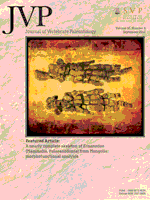In this study we describe an isolated petrosal from the middle Eocene of northwestern Argentina assigned to Dasypodinae (Mammalia, Xenarthra, Cingulata). The specimen was recovered from the Geste Formation, Antofagasta de la Sierra, Catamarca, Argentina. The material is an incomplete right petrosal preserving the pars cochlearis and the anterior third of the pars canalicularis. It is described in detail and compared with extant and fossil cingulates. Additionally, we performed a cladistic analysis in order to define its phylogenetic position. The most remarkable traits of this petrosal include an anteromedially-posterolaterally elongated Promontorium, open cavum supracochleare, wide and smooth crista interfenestralis, roof of the post-promontorial tympanic sinus triangular, reduced, and well separated from the stapedius fossa, and poorly developed epitympanic wing and crista petrosa. The phylogenetic analysis reveals affinities with Dasypus and Stegotherium that are supported by the weakly developed crista petrosa and the reduced dorsal and ventral extension of the cerebellar surface of the pars cochlearis in relation to the size of the internal acoustic meatus. The information provided by this element indicates the existence of several characters that were already present in the Eocene, such as an elongated Promontorium, and a step between the stapedius fossa and the roof of the post-promontorial tympanic sinus. We propose hypotheses of evolutionary change in the auditory region of cingulates, including the medial expansion of the roof of the post-promontorial tympanic sinus and the emergence of a conspicuous crista petrosa.
How to translate text using browser tools
1 September 2012
The Most Ancient Xenarthran Petrosal: Morphology and Evolutionary Significance
Judith Babot,
Daniel A. García López,
Timothy J. Gaudin
ACCESS THE FULL ARTICLE





